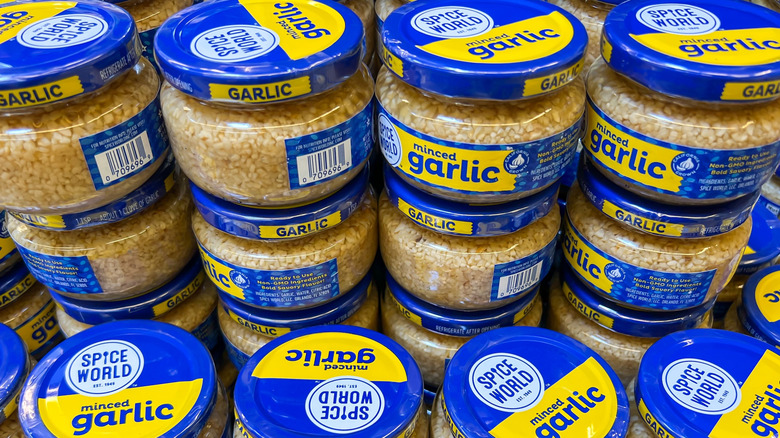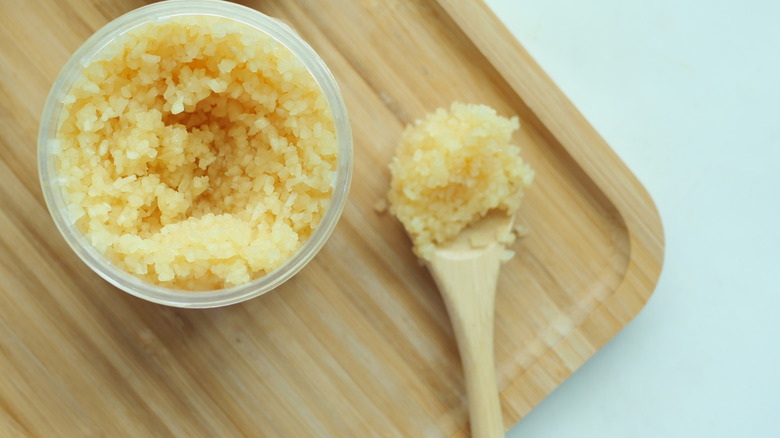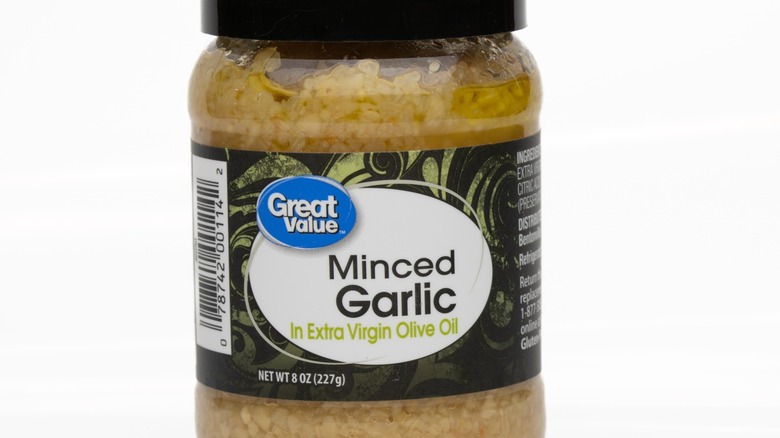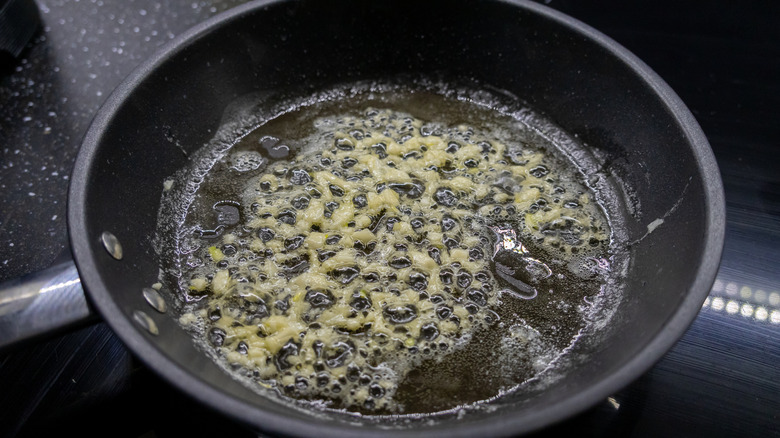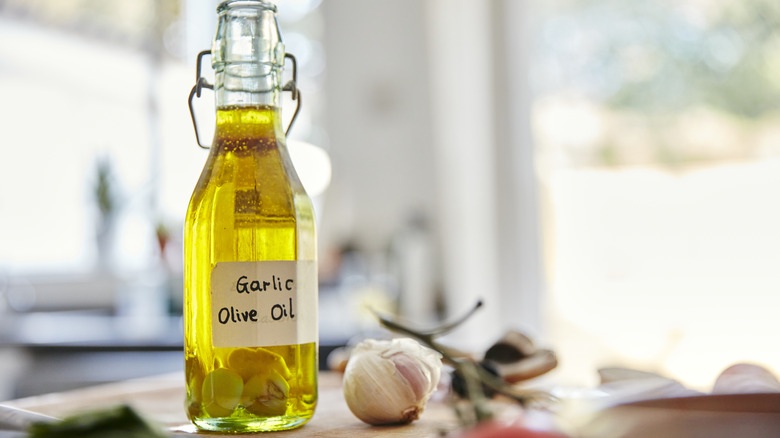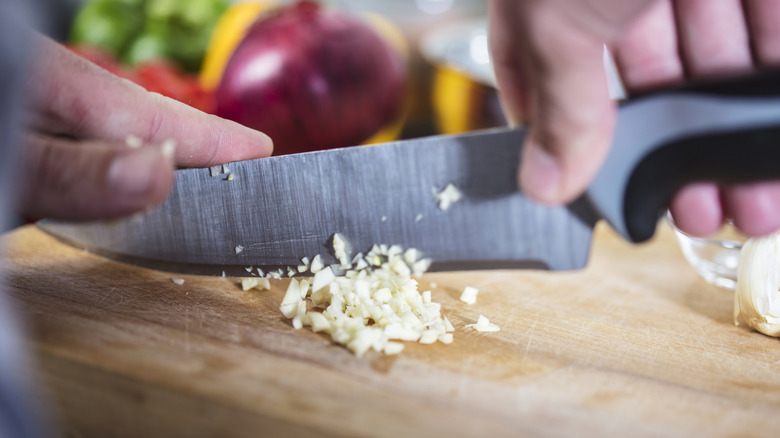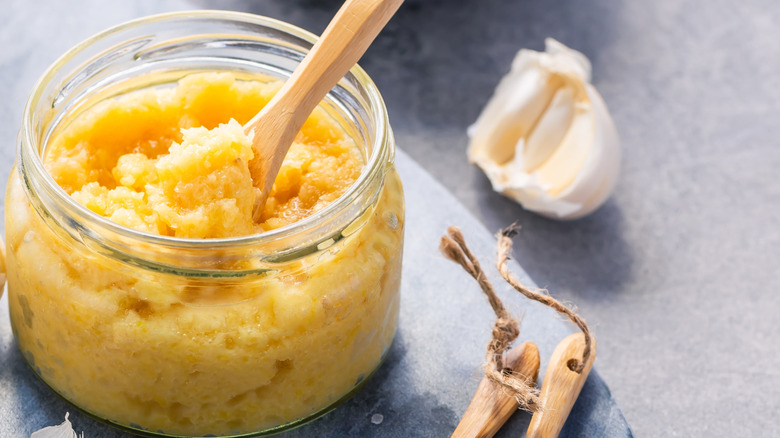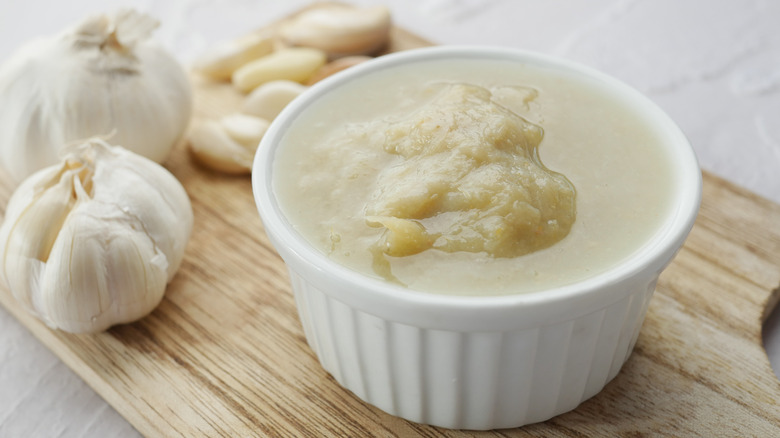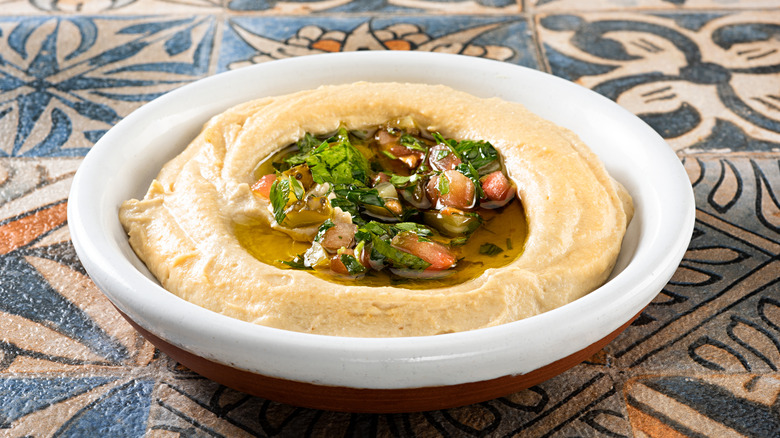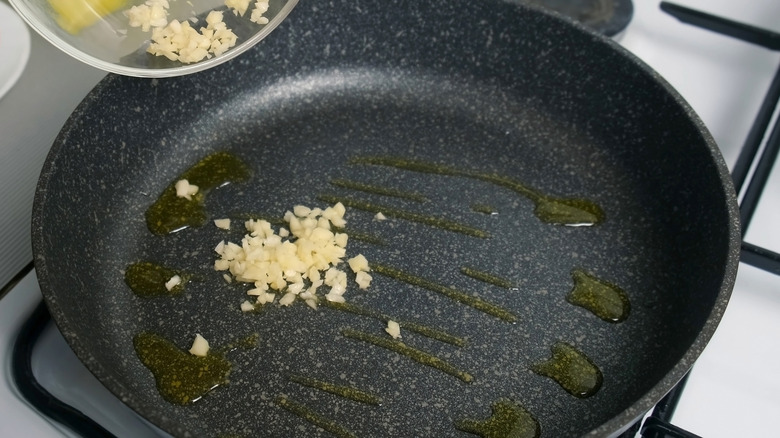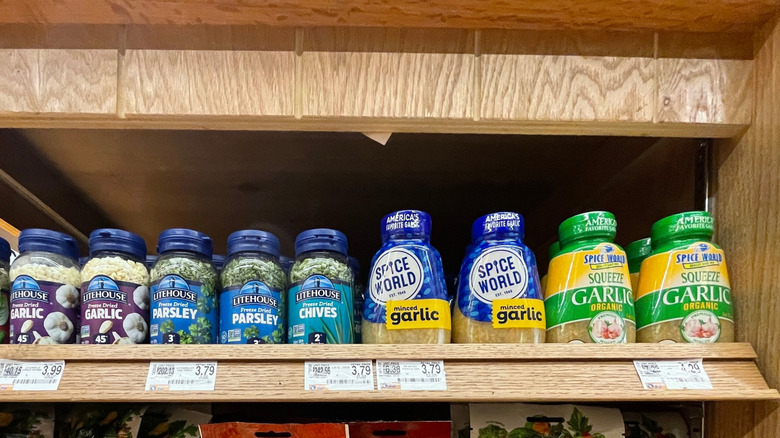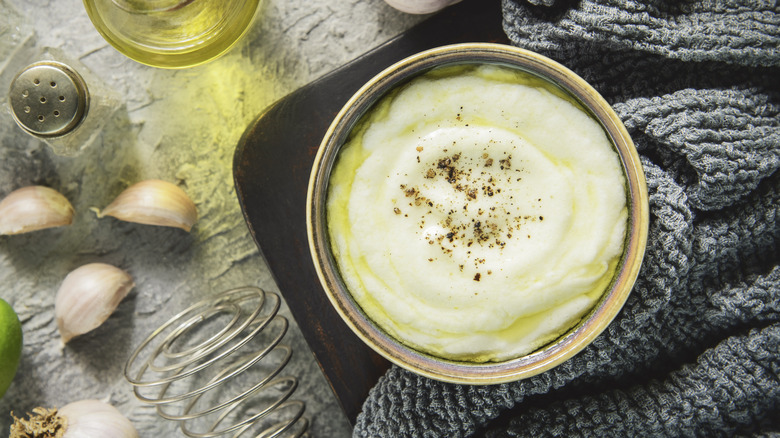Mistakes Everyone Makes With Jarred Garlic
Jarred garlic — or "jarlic" as it's sometimes called — is one of those kitchen shortcuts many people secretly use. Some people are snobby about it, claiming it should be fresh garlic or nothing at all. But isn't it great if an ingredient can make cooking more accessible for all? The trouble is, there are some common mistakes everyone makes with jarred garlic — and these are a big part of what gives it a bad rap. It's not that it's awful across the board, but rather that you need to understand how and when to use it.
One of the great things about jarred garlic is that it makes meal prep quicker and easier. Sometimes, the barrier between you and cooking from scratch is something seemingly small, like having to peel and dice ingredients. Plus, there are people with disabilities or injuries that make prepping garlic hard or impossible. But you have to remember there's a time and place for the jarred variety. It's not going to work in certain garlic-heavy dishes. Plus, if you want to make the most of it, you need to learn how to use it to its best advantage, such as throwing more of it in a dish than you would the fresh stuff.
Learning about the common errors people make with jarred garlic can help you avoid them or fix them if you run into problems. It will help you get more out of this shortcut ingredient, so it's almost as good as its fresh counterpart.
Using too much or too little
With jarred garlic, you need to learn how much to use. Any recipe you're likely to follow is bound to list the number of cloves to use, but where does that leave you when you're dealing with pre-minced stuff? You can learn how much roughly equates to one clove, but there's more to it than that.
One of the problems is that cloves aren't uniform sizes. Some are the size of a little fingernail while others are more like a whole thumb. And you don't always know what size cloves the recipe developer is dealing with. Usually, recipes refer to an average clove, so when using fresh garlic, most people adjust according to the sizes they have — using more if they've tiny cloves and less if they have large ones. Half a teaspoon of minced jarred garlic roughly equates to an average clove, so that settles that issue.
But the other factor to contend with is that jarlic tends to be significantly milder than fresh. The aromatic compounds start to degrade once it's cut, so pre-minced alternatives aren't as punchy. Especially if your jar has been hanging out in the fridge for a while. So, depending on the recipe and how strong you want the garlic flavor, you may need to use more than half a teaspoon per clove. It often takes a bit of experimentation to find what works for you.
Storing it incorrectly
One of the mistakes people often make with jarred garlic is storing it incorrectly. It's different from the fresh stuff, which is why things can get confusing. Fresh garlic is one of those foods you don't actually need to refrigerate. In fact, it's best not to because it sprouts more quickly in the fridge. But the jarred version has a different set of rules.
When you buy jarlic, it's generally shelf-stable, meaning that you can store it in the pantry, saving you some fridge space. Once it's open, however, it needs to be refrigerated. This is because jarred food is sealed and airtight. Without any oxygen or bacteria from the outside world getting in there, it's safe to eat for a long time even when kept at room temperature.
Once you open it, though, it's a different matter. Oxidation and bacteria cause it to go bad more quickly. But keeping it cool in the fridge slows this down. Jarred garlic also contains preservatives, meaning it stays fresh for longer than regular minced garlic would. Learning how to store it correctly preserves its shelf-life, which is part of the appeal of the jarred stuff, anyway.
Not draining off the liquid it comes in
Jarred garlic is suspended in liquid. It's often either oil, water, or a mixture of the two. However, it's also packed with preservatives to help keep the jar's contents fresh. It serves an important purpose, but this doesn't mean you need to put it in your food — its flavor often leaves a lot to be desired. It's better to drain off as much of the liquid as possible before you add your garlic to the pan.
We're not saying that you should totally drain all the liquid from the jar as soon as you open it. Unless you're planning to use the whole jar in one sitting (which is unlikely unless you're cooking for a huge crowd), you're going to need the liquid in the jar. It will help preserve the unused garlic when you stick it in the fridge. Rather, you should drain the garlic that you're using.
Rather than spooning out some garlic and its liquid and throwing it all in a pan, aim to discard the liquid. If you're in a hurry and want to avoid extra dishes, this might be as simple as tipping the spoonful of garlic against the inside of the jar, attempting to get rid of as much of the fluid as you can without tipping the garlic back in. However, this will leave some of the liquid, so if you want to be thorough, use a fine mesh strainer. Once you've drained the liquid, use the garlic as normal.
Using it to make garlic oil
You can use garlic to make delicious infused olive oil, and you can then use this flavored oil for finishing dishes. However, you should never use jarred garlic to make garlic oil. We can see the appeal of using garlic that requires zero prep. Or maybe it's just what you have to hand, but it isn't the right choice for an infused oil.
The thing about garlic oil is that garlic should be center stage. It needs to be strong and punchy to infuse its flavor through a large quantity of oil. Jarred garlic just isn't strong enough to pull this off. The resulting oil might have a hint of garlic to it, but it wouldn't be anywhere near as flavorful as you'd hope.
The other factor is that jarlic lacks complexity. It's good enough to use in a pinch, especially when you've got other flavors in the mix to carry off the dish. But with garlic oil, you've got nothing but garlic and the flavor of the olive oil. In this context, it's obvious that the jarred version doesn't taste as good as fresh. There's nowhere to hide and that becomes a problem.
Luckily, if you want to make this kind of infused oil, it's quite simple. You use whole garlic cloves so there's minimal prep. Sure, you have to do some peeling, but it's not like you have to mince every clove.
Treating it like it's as flavorful as fresh garlic
Some people try out jarred garlic, decide that it's not flavorful enough, and move on. But their mistake is often cooking with it as though it tastes just as punchy and complex as fresh garlic. You can't treat fresh and jarred varieties identically and expect the same results. Your food will be much tastier if you acknowledge that garlic from a jar isn't as flavorful as fresh cloves and adjust accordingly.
The obvious change to make here is to use more jarred garlic than you would fresh cloves. This works for some recipes but if you overdo it, you might get a lot of flat, one-note flavor. Your dish will get a hit of garlic but without much complexity. A better alternative is to use a little more garlic than you usually would but also make up for what it's lacking in other ways.
You could choose to use more of any other alliums in your dish, such as onions, scallions, leeks, or shallots. Another option is to add more flavor from herbs and spices than you otherwise would. Just be careful not to overdo it. Fresh soft herbs are particularly good for finishing dishes or incorporating right at the end of cooking. They add a lot of complex flavor with very little effort.
Keeping it for too long
Some people assume that jarred garlic lasts forever and end up keeping it for too long. Sure, it's true that its shelf life is longer than that of fresh cloves, but this doesn't mean you can keep it at the back of your fridge for years, dipping into it when you're in need. Not only will it lack flavor after a while, but it can also spoil and be unsafe to eat.
What you need to know before buying jarred garlic again is that it has a shelf life. Unopened, it lasts for between 12 and 18 months. This is way longer than a bulb of fresh garlic lasts, which is around 6 months if stored correctly (but it's likely bulbs you buy in a store will have been stored for at least a couple of months or two already).
Once opened, it starts to spoil more quickly. It varies between brands, so check the packaging, but you can expect opened jarlic to last around 3 months. If you're wondering how long minced garlic lasts in the fridge, it's normally just a few days for the fresh cloves you've chopped yourself. So, jarred versions keep for a while in comparison, but if you've had a pot languishing in your fridge for years, it might be time to throw that out.
Using garlic paste instead of minced jarred garlic
If you're looking to get similar results to using fresh minced cloves, jarred garlic is where it's at. However, many people pick up a tube of paste, expecting the same outcome in recipes — this is a mistake. Garlic paste has its place, but it's not a like-for-like replacement for the minced fresh stuff.
Food is about texture as well as flavor. When a dish calls for minced garlic — rather than crushed or paste — you expect to get some texture from it. You also get little bursts of garlic as you eat. The flavor will be infused through the whole dish to some extent, but you'll have more garlicky mouthfuls when you get small chunks on your fork.
Using garlic paste instead means that there's none of this experience. The garlic flavor distributes more evenly through the dish, which is good in some cases but it's not what most recipes are asking for. A paste of garlic and ginger is commonly used in Indian cuisine, for instance, and that's great, but you couldn't sub minced garlic and expect the same results. So, don't buy the paste and use it when a recipe calls for minced garlic. The jarred version is what you need in this instance.
Not trying it raw
Many people believe that you have to cook jarred garlic, but if you aren't trying it raw, you're missing out. That's not to say that you always have to use it raw, but it's something to consider for certain recipes. In raw uses, it has its benefits over fresh garlic. It might not always be the best choice, but it's some folks' preferred option.
What makes jarred garlic different from fresh is its milder flavor. This is because it's been cut, heat treated, and stored in liquid. And, in some cases, this less punchy finish is an advantage. If you've ever had hummus that tasted like nothing but raw garlic or a salad dressing so garlicky it was practically spicy, you'll understand.
Possible places to use it raw include dips, dressings, and pesto. Rather than having to temper your fresh garlic by sautéing it, roasting it, or soaking it in citrus juice, you can use it straight out of the jar and it won't be overwhelming. If you're somebody who generally avoids using raw garlic in recipes because it's too harsh, the jarred variety might be an acceptable alternative.
It's all about working to the strengths of this product. Sure, there are plenty of recipes where you want a wallop of flavor and jarlic doesn't cut it. But, then you have occasions when it's just the thing for the job. No ingredients are good for everything, so maybe it's time to stop treating jarred garlic like it should be.
Using too much heat and burning it
Burning garlic is easy to do. In fact, one of the false facts about garlic you thought were true is that you should add onion and garlic to the pan at the same time. In most cases, you should sauté the onion for a while first. But overdoing it on the heat is another mistake — and one that's common with jarred garlic. Too much heat leads to burnt garlic that has an unpleasant bitter flavor.
But sometimes you're going to be cooking it on its own. For instance, if you're making something like pasta con aglio e olio (with garlic and olive oil). How do you stop it from burning then? Well, the key is to start by adding it to a cold pan with oil, then gently heat it on a medium-low heat, moving up to a medium heat if needed. Cook it slowly until you get a sweet garlicky aroma, not a bitter burned one. The minced garlic should be soft and pale — if you notice browning, you're on the wrong track.
When it's nicely softened, it's done. Take it off the heat right away or add the next ingredient on the list to keep it from burning. If you think it's getting close to burning, remove it from the stove and add some extra oil to cool it down and stop or slow the cooking process. If you're using a pan that retains heat well, such as cast iron, remove the garlic from the pan.
Assuming every brand is equally good
Where you can go wrong with jarred garlic before you've even started is by assuming that every brand is equally good. Some folks absolutely swear by it, while others wouldn't touch it for a hundred bucks, and part of this might be down to the varieties they're tried. Just like most products, some are better than others. So, don't knock it if you've only ever picked up the cheapest version at your local grocery store.
First off, we'd recommend avoiding the kind that comes suspended in water. This tends to have the most muted flavor and a soggy texture. The excess water content can cause it to steam in the pan, rather than sautéing properly and getting more flavorful. Versions packed in oil tend to be better, especially those that come in olive oil. This can elevate the flavor rather than detract from it.
So, you may have to try a few different brands of jarred garlic before you find one you love. We're not saying you have to spend a fortune, but the pricier options often taste better than the cheap ones, so it's worth spending an extra dollar or two. Jarred garlic lasts a good long time in the fridge, so it's worth splashing out on a decent brand instead of struggling through a jar of the most basic stuff, perhaps leaving half of it because it just wasn't up to scratch.
Using it in recipes where garlic is the star
There's a time and a place for jarred garlic and you have to admit there are some dishes in which only fresh garlic will do. When this allium is just one ingredient in a range of aromatics and can settle into the background, jarlic is fine. But if garlic is going to be the biggest bringer of flavor in a dish, you'll be much better off reaching for a fresh bulb.
Making garlic bread, Chinese-style garlic sauce, toum, or aioli? You're not going to get the complexity of flavor that you need from jarred garlic. These are recipes that need the pep and depth of flavor that comes from whole, fresh cloves — and there's not much you can do about that.
The thing is, it doesn't have to be all or nothing with jarred garlic. Just because you sometimes use it, you don't have to do so every time. Even if 99 days out of 100, you reach for the jar in your fridge, you can still go out and buy a bulb of the fresh stuff when you're making a recipe that truly needs it. The trick is realizing when you've got to pull a knife out of the drawer and get to work peeling and chopping, and when reaching for that trusty jar in your fridge is totally fine.
